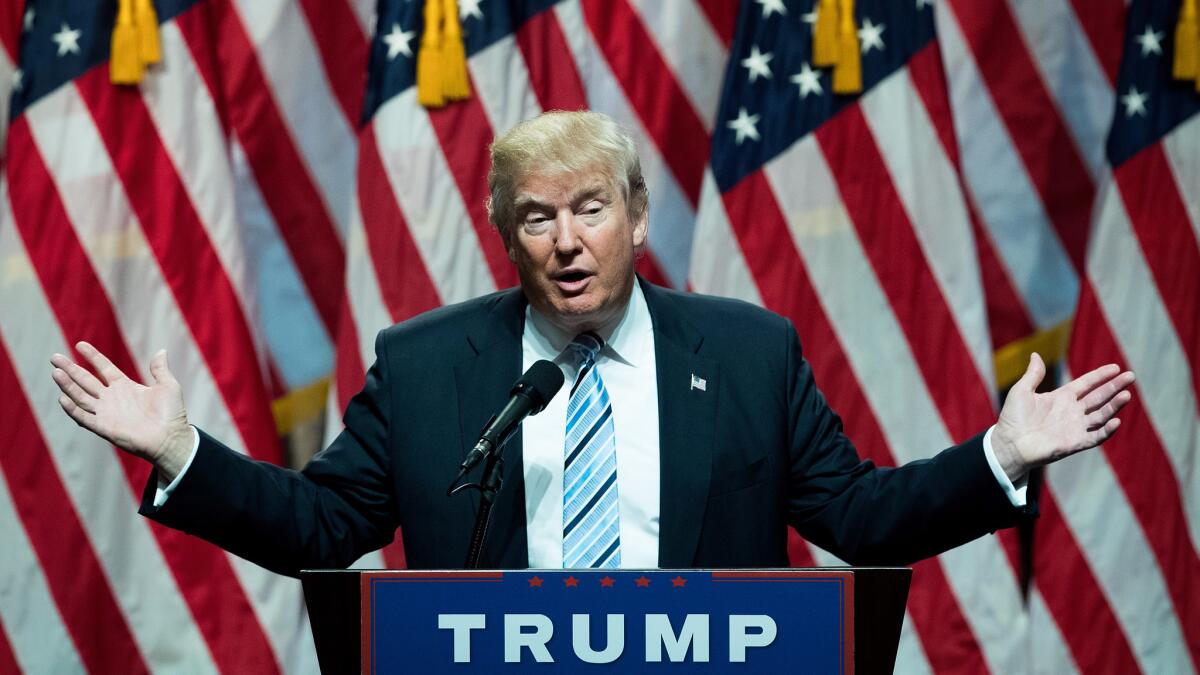How to invest for the Age of Trump

- Share via
Investing for the Age of Trump presents some special considerations for financial advisors.
For one, there’s the risk of a 3 a.m. Donald Trump tweet that torpedoes one of your favorite stocks.
Never before have advisors faced the kind of power the new president can wield over financial markets and individual investments via social media. Witness Trump’s use of Twitter in recent weeks to criticize publicly traded companies including Ford, General Motors, Boeing and Lockheed Martin for business decisions he didn’t like.
But it’s the bigger picture that will be crucial for advisors to get right: choosing the optimal mix of stocks, bonds and other assets appropriate for the economic backdrop under Trump, as well as for each client’s risk tolerance.
Here are some of the concerns and opportunities advisors see as the Trump era begins:
Bonds are the biggest worry
Short- and long-term interest rates jumped immediately after the election, as traders and investors bet that Trump will succeed in boosting U.S. economic growth.
What’s more, the Federal Reserve in December raised its benchmark short-term rate for the first time in 12 months.
In theory, stronger growth should mean rates will continue to rise from the super-low levels of the last eight years. The yield on the benchmark 10-year U.S. Treasury note now is 2.38%, up from a record low of 1.32% in July but still relatively depressed historically.
Higher market rates make new bonds more attractive. But they also devalue the trillions of dollars in older bonds that carry lower fixed rates. As a result, investors’ bond holdings mostly lost ground in the second half of 2016. The share price of the popular Vanguard Total Bond Market exchange-traded fund slid 5.8% from its summer peak to its December low.
That wiped out the equivalent of two years’ worth of interest earnings from the fund.
“People don’t realize the damage that bonds can cause” as market rates rise, said Todd Morgan, chairman of Bel Air Investment Advisors. For uninformed investors, “it’s what is going to cause the most pain” if the economy accelerates, he said.
To limit potential bond losses, Bel Air is keeping clients’ bond holdings mostly in issues that mature within 2.5 years, Morgan said. Shorter-term bonds decline less than longer-term issues when interest rates rise.
Laila Pence, president of Pence Wealth Management in Newport Beach, also is keeping clients’ bond holdings in shorter-term issues. In addition, she said the firm has moved money into floating-rate bonds that pay more as market rates increase.
More excitement over U.S. stocks
Typically at new market highs, some clients call Pence wondering if it’s a good time to sell stocks, she said.
But this time, “our clients are excited and they are more bullish,” she said.
Morgan said Bel Air over the last year has raised stocks from 30% to 40% of total assets in one of its benchmark portfolios, with 25% in bonds and 35% spread across a variety of other investments.
But he said he still finds many people prefer to keep “too much in cash and too much in bonds.” That may change if investors see Trump’s pro-growth policies such as tax cuts, infrastructure spending and deregulation take root, Morgan said.
Many advisors and fund managers continue to favor U.S. banks and other financial stocks as a way to play rising interest rates.
“I still think there may be opportunity there,” said Jerry Dodson, whose highly rated Parnassus Fund in San Francisco has stakes in companies including brokerage Charles Schwab and insurance giant Progressive Corp.
Foreign stocks still attractive
Many Wall Street pros in recent years have been recommending foreign shares as better values than richly priced U.S. issues. Yet foreign markets in general have continued to lag behind the U.S. market.
That isn’t deterring foreign-stock fans.
Jim Paulsen, chief investment strategist at Wells Capital Management, notes that if the global economy finally picks up steam, profit growth at foreign companies could be impressive. Compared with U.S. companies, many foreign firms “are at a younger point in their earnings cycle,” he said.
Bank of America Merrill Lynch’s chief investment strategist, Michael Hartnett, expects European stocks to produce double-digit returns this year. The plunge in the euro from $1.40 three years ago to $1.06 now has made European exports cheaper.
The problem is that the slump in most currencies against the dollar also has devalued Americans’ overseas investments. So far this year, however, the dollar has weakened modestly. If it slips further, or just stabilizes, that could end the currency drag on U.S. investors’ foreign holdings.
Emerging-market stocks remain depressed: The average emerging-markets mutual fund has lost an average of 3.2% a year over the last three years while the U.S. Standard & Poor’s 500 index has surged 9.5% a year.
A big risk with emerging markets is Trump’s trade-war threat against major exporters including China and Mexico. Still, investors who like to go against conventional wisdom “should be tempted by emerging markets,” Hartnett said.
Is it time to think about timing?
With U.S. stocks flying high, and the bull market nearing its eighth birthday, the lure of selling out completely and waiting for the next bear market to buy is understandable.
The problem is that even the savviest professionals find that timing the market correctly is virtually impossible. Selling may be easy; getting back in is not.
Parnassus Fund’s Dodson has been a star stock-picker for decades. The fund has gained an average of 9.6% a year over the last 10 years versus 7% for the S&P 500.
In his younger days, Dodson said, he periodically tried to make timing decisions about broad market trends. “But I stopped doing it because it hurt results,” he said.
Now, he said, he pays attention only to the fundamentals of his individual stocks.
Of course, having some cash reserves in a portfolio is a good idea if you’re hoping to take advantage of a market sell-off in the future. The challenge is having the discipline to buy into a falling market.
That’s one big advantage that investors in 401(k)-style accounts have: Because they’re investing with every paycheck, they can be sure they’ll be buying low when stocks drop.
Simple, but elegant.
ALSO
Trump’s market: bear, bull or lamb?
Seven steps to improve your finances in 2017
Australian firm plans nation’s largest geothermal plant in Imperial Valley
More to Read
Inside the business of entertainment
The Wide Shot brings you news, analysis and insights on everything from streaming wars to production — and what it all means for the future.
You may occasionally receive promotional content from the Los Angeles Times.










